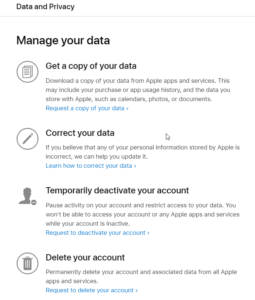Apple grows its suite of tools provided on Apple’s Data and Privacy webpage, which earlier consisted of:
- – Get a copy of your information
- – Correct your data
- – Temporarily deactivate your account
- – Delete your account.

With this new function provided by Apple, iPhone users will be able to transfer images and videos from iCloud Library to Google Photos. This suggests that if you are falling short of the area on iCloud or the storage is practically complete,you can transfer some media to Google Photos without paying additional. You can also check another post like Questions to ask a freelance writer.
How To Transfer ICloud Photos To Google Photos
In this article, you can know about transfer iCloud Photos to Google Photos here are the details below;
Like iCloud Photos, Google Photos is a cloud storage service, and it permits keeping all photo and video libraries on the cloud enabling access from anywhere, anytime.
Isn’t this great news? Well, yes, now you can officially transfer iCloud Photos to Google Photos.
However, how does this transfer of iCloud Photos to Google Photos work, and what are the pre-requirements?
Introduction:
– How to directly transfer iCloud Photos to Google Photos?
– Will Transferring Photos and Videos from iCloud Affect the Stored Content?
– Can I transfer all data?
– Who all can access this service?
To understand it in detail, check out even more.
Before you begin transferring iCloud Photos to Google Photos, make sure you follow the below-mentioned things:
– iCloud Photos should be utilized to conserve photos and videos with Apple.
– Two-factor authentication ought to be made possible for in your Apple ID.
– You have a Google Account to utilize Google Photos.
– Sufficient storage area must be offered in your Google Photos.
As soon as all the above is inline, you can begin transferring images from iCloud to Google.
Additional Information:
Your Google account’s overall storage area refers to the data moved from iCloud to Google Photos. This indicates, if more than 20,000 images are transferred, they will not appear in the album because Google Photos has a limitation of 20,000 pictures per album. Also check operation did not complete successfully.
How to directly transfer iCloud Photos to Google Photos?
To transfer images and videos from iCloud to Google Photos, you require to follow the actions listed below:
1. Visit privacy.apple.com and check in with your Apple ID that you wish to utilize to move information.
2. Select the “Transfer a copy of your data” alternative.
3. Click “Request to transfer a copy of your information.”
Note: Since the service is available in selected nations like Canada, Australia, the European Union, Iceland, New Zealand, the United Kingdom, Norway, Liechtenstein, and the United States, you will get this option belong to these locations.
4. Select Google Photos from the drop-down menu.
5. Afterwards, choose the information you wish to transfer. If you wish to move both Photos and Video, choose the box beside them, else checkmark the box for the information you want to transfer.
6. Look for the offered storage space on Google Photos, as lack of it will stop the process briefly.
7. Log in to your Google account > permit Apple to add chosen data to Google Photos account
8. Follow on-screen instructions, validate details > “Confirm Transfer.” Apple will now move iCloud pictures and videos to Google Photos.
Additional Information:
To begin with the information transfer from iCloud to Google Photos, you’ll require to sign in to your Google account. When that is done, the transfer procedure will start. After that, you’ll get an email informing you about the information transfer, and when done, you will get a verification email. Also, if the data transfer demand is canceled in the middle, some pictures and videos are already moved, it will remain in Google Photos. Also check types of bank.